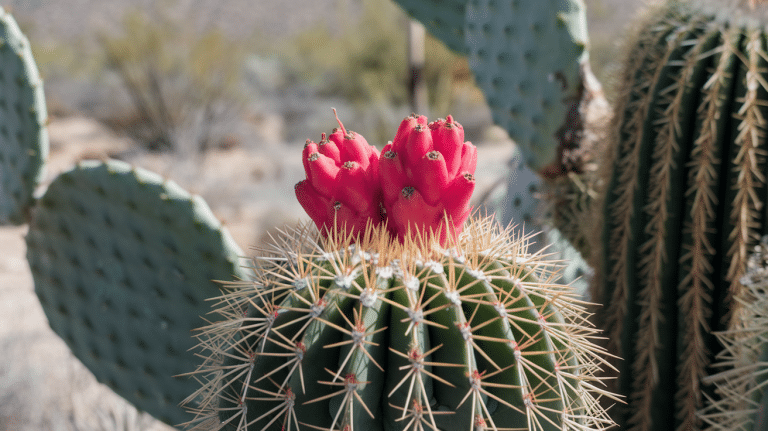Ever noticed a small, bright fruit popping out from the top of your Melocactus and wondered what it is?
You’re not alone. That little fruit can feel like a surprise—especially if you didn’t even spot a flower first.
Melocactus is a special kind of cactus that grows a woolly cap on top as it matures.
This cap, called a cephalium, is where all the magic happens. Flowers bloom from it, and soon after, fruit can show up.
In this guide, you’ll get clear, simple info about how that fruit forms, how to care for your plant, and how to grow new ones from seed.
So you feel more confident and connected to your Melocactus.
What is a Melocactus?
Melocactus is a group of cacti that stands out for one special feature — the cephalium.
Melocactus is a woolly or bristly structure that grows from the top once the plant is mature. It’s also where the flowers and fruit appear.
These cacti are often short and round, but once the cephalium forms, they take on a distinct look.
The cephalium doesn’t go away; it keeps growing as the plant ages. This makes Melocactus easy to tell apart from other cacti.
One more reason people find them interesting is how they flower. Some bloom in the daytime. Others open only at night or at dusk. That blooming behavior can make a big difference in how they fruit.
Melocactus Fruit Explained
Melocactus fruit grows from a cactus that’s unlike most others. Its small, colorful fruit appears on top of a special structure called the cephalium.
These fruits are not just eye-catching—they have a few surprising uses, too.
How the Fruit Develops
Fruit in Melocactus grows from the cephalium. Before that happens, the cactus must flower.
Some species need a second plant nearby for pollination. Others might manage on their own.
The flower opens from the cephalium, and after pollination, a small fruit forms in that same spot.
The fruit often grows fast, sometimes appearing just days after the flower.
Some growers notice that fruits appear even when they think there was no pollination. This raises questions about whether some species can pollinate themselves.
What the Fruit Looks Like
Melocactus fruit is usually pink, red, or magenta. It’s shaped like a finger or a small tube. It sticks out of the cephalium, sometimes looking like it was squeezed out.
The fruit often ripens quickly. One day, it might not be there, and a few days later, you could find more than one.
Some fruits dry up fast, and others drop seeds while still fresh.
Which Melocactus Species Produce Fruit
| Species | Bloom Habit | Fruit Notes |
|---|---|---|
| M. azureus | Frequent daytime bloomer | Rarely forms fruit on its own |
| M. matanzanus | Day and night blooms | Often, fruits with nearby cacti |
| M. peruvianus | Less frequent bloomer | May need specific conditions |
| M. x albicephalus | Regular bloomer | Produces multiple fruits |
| M. ernestii | Uncertain bloom data | Hard to track in cultivation |
Pollination
Some plants can pollinate themselves, while others need help from another plant.
Ariocarpus fissuratus usually depends on cross-pollination for better seed quality. This means pollen from one plant is transferred to another to produce healthy seeds.
Do Melocactus Self-Pollinate?
Some species of Melocactus can self-pollinate, but not all. If you have just one plant and it produces fruit, it likely pollinates on its own.
However, many types depend on insects or nearby plants for pollination. This means having only one may reduce the chances of fruiting.
Role of Insects or Manual Pollination
In their natural habitat, bees, moths, and flies often carry pollen between flowers.
These helpful visitors increase the chances of successful pollination and fruit production.
If your Melocactus is indoors, isolated, or not flowering well, you can step in. Use a soft brush or cotton swab to move pollen from one flower to another.
This simple step can encourage fruit development, especially when the plant is healthy and blooming.
Tips to Encourage Fruiting
Here are some easy ways to help your Melocactus produce fruit:
- Keep more than one plant: If possible, place a few Melocactus close together. This helps natural or hand pollination happen more easily.
- Avoid moving them often: When a plant is in bloom, keep it in a stable spot with good light. Too much movement can interrupt flowering.
- Try hand-pollination: If fruits rarely appear, use a small brush to transfer pollen gently between flowers.
With patience and the right setup, many growers can enjoy seeing their Melocactus bear fruit, even with a small collection.
Growing Conditions that Support Fruiting
To support fruiting, Melocactus needs warm temperatures, plenty of sunlight, and well-draining soil.
Consistent watering during the growing season also encourages healthy blooms and fruit formation.
Light, Soil, and Water Needs
Ariocarpus fissuratus does well in bright sunlight. It needs full sun for most of the day, but in very hot areas, a bit of afternoon shade can prevent sunburn.
The soil should be fast-draining—use a cactus mix with added sand, pumice, or perlite. This helps prevent root rot by keeping the roots dry.
Water only when the soil is completely dry. During the cooler months, reduce watering to a minimum, just enough to keep the plant from drying out too much.
USDA Hardiness Zones
Most Melocactus are suited to zones 11–12, but some growers in zones 9–10 have success by protecting them from frost.
A basic chart could look like this:
| Zone | Outdoor Safe | Needs Protection |
|---|---|---|
| 9–10 | Not recommended | Yes, during winter |
| 11–12 | Yes | No |
Pot vs. Ground Planting Considerations
When deciding between pot or ground planting for Melocactus, there are several things to keep in mind.
These cacti often do better in pots, especially in areas with cooler winters. Potted plants can easily be moved indoors or to a warmer spot if the temperature drops.
On the other hand, planting them in the ground may work well in regions that stay warm year-round.
In-ground plants often tolerate heat better and can grow a bit more naturally.
However, they are harder to protect from sudden cold snaps. Drainage is also easier to control in pots, which helps prevent root rot.
So, the choice really depends on your local climate and how much control you want over growing conditions.
Harvesting Melocactus Fruit
Melocactus fruit is ready to harvest once the pinkish, club-shaped fruit emerges from the wooly top of the cactus.
These fruits can be gently pulled from the plant by hand when ripe, usually during the warmer months.
It’s best to collect them early in the morning to avoid heat stress on the plant.
Always use clean hands or tools to prevent damage or infection.
How to Know When It’s Ripe
When the fruit of a Melocactus is ripe, it’s usually quite easy to tell.
It becomes soft to the touch and often sits loosely on top of the cephalium, requiring only a gentle pull to come off.
Sometimes, the ripe fruit might even be hanging off the spines, making it more visible.
Its color often becomes brighter, and the surface may appear slightly glossy.
Be sure to check the base—if it detaches without resistance, it’s ready to eat.
Avoid forcing the fruit off, as unripe ones tend to cling tightly and may tear if pulled too hard. Patience helps ensure the best taste and quality.
Storage Tips
To keep seeds in good condition, store them in a cool and dry place.
Use breathable containers like paper envelopes instead of plastic, which can trap moisture.
While some seeds can stay viable for months, using fresh ones often gives better results.
Always label your containers with the seed type and date for easy tracking.
Growing Melocactus from Seed

Growing Melocactus from seed takes time and care, but it’s a rewarding process for plant lovers.
These cacti need warmth, light, and the right soil to sprout and grow strong. With patience, you’ll see the first signs of life in just a few weeks.
Germination Steps
- Use a shallow container with drainage holes.
- Mix cactus soil with perlite or pumice (50/50).
- Wet the soil, then sprinkle seeds on top.
- Cover lightly with fine sand or grit.
- Use a humidity dome or clear lid.
- Place in bright, indirect light (not full sun).
- Keep the setup warm (around 75°F) and humid until germination starts.
Common Germination Issues
Too much moisture can lead to mold, which may harm the seeds before they even start to grow.
Old or expired seeds might not sprout at all, no matter how ideal the conditions are.
Also, placing seed trays under direct sunlight for long hours can cause overheating, drying out the soil too fast, and damaging the seeds.
Timeline of Seedling Growth
Germination usually begins within 1 to 3 weeks, depending on warmth and moisture levels.
After sprouting, Melocactus seedlings grow very slowly and can remain tiny for several months.
The cephalium, which is the special growth on mature plants, might not appear until the cactus is a few years old.
Melocactus Troubleshooting
If your Melocactus isn’t producing fruit, it might simply be too young. These plants need time to mature before they can bloom and fruit.
Lack of sunlight or not having another cactus nearby for pollination can also affect fruiting.
It’s also smart to check for plant health issues.
Overwatering can cause soft spots, and pests like scale insects or mealybugs may slow growth.
If the soil doesn’t drain well, root rot could be stopping your cactus from thriving.
Signs of Unhealthy Plants and Fixes
- Wrinkled or soft stems = not enough water or root issues.
- Pale color = not enough light.
- Burned tips = too much sun without shade.
Conclusion
We’ve covered everything you need to start and care for Melocactus, from understanding the plant to growing it from seed and even helping it fruit.
This guide gives you a full view of what to expect and how to handle each step.
It’s not just about growing a cactus—it’s about seeing it thrive under your care.
If you’ve made it this far, you’re likely serious about giving this plant the best chance. And that’s what matters most—your time, your effort, and your connection with it.
Keep the basics in mind, stay patient, and enjoy the process. You’ve got what it takes to grow a healthy, fruiting Melocactus.













